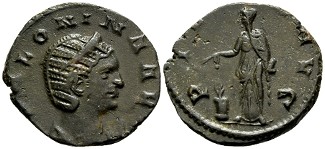Fine Coins Showcase
Antiquities Showcase
Show Empty Categories
Shop Search
Shopping Cart
My FORVM
Contact Us
About Forum
Shopping at Forum
Our Guarantee
Payment Options
Shipping Options & Fees
Privacy & Security
Forum Staff
Selling Your Coins
Identifying Your Coin
FAQs
zoom.asp
Home ▸ Catalog ▸ |Roman Coins| ▸ |Crisis & Decline| ▸ |Salonina||View Options:   | | | | | | Salonina was the wife of emperor Gallienus. A very beautiful and intelligent woman, she was extremely loyal to her husband. Opinion is divided as to whether she was murdered in the purge of Gallienus family after his murder, or if she survived. |


Pietas in traditional Latin usage expressed a complex, highly valued Roman virtue; a man or woman with pietas respected his or her responsibilities to the gods, family, other people and entities (such as the state), and understood his or her place in society with respect to others.RA115104. Billon antoninianus, Göbl MIR 1470, RSC IV 79, Hunter IV 32, RIC V-1 S79, SRCV III 10646, gVF, nice portrait, tight flan, weight 2.809 g, maximum diameter 18.4 mm, die axis 180o, Siscia (Sisak, Croatia) mint, c. Aug 267 - Aug 268 A.D.; obverse SALONINA AVG, draped bust right, wearing stephane, hair in ridges and in plait looped below ear up the back of head, crescent behind shoulders; reverse PIETAS AVG (to the piety of the Emperor), Pietas standing left, offering from right hand over altar at feet, box of perfumes in left hand; from the estate of Curtis D. Barker, ex Littleton Coin Company;


Juno was the chief female divinity in the Roman pantheon. She was the wife of Jupiter and a member of the Capitoline Triad. She had many different aspects, such as Juno Moneta, Juno Sospita, and Juno Lucina, but here she is depicted as Juno Regina, "Juno the Queen." Juno is usually shown holding a patera, scepter or a statuette of Athena, and is often accompanied by a peacock.
In matters of lettering and iconography, RIC V-1 29 (Rome) and 64 (Antioch) are identical. The only way to separate the two is on the basis of style, which the crudely rendered 'Ns' on the obverse are but one piece of evidence in favor of Rome, with the generally larger size of every individual element of the coin being another. It is a bit like the nerdy way of sorting 1982 brass Lincoln cents from their copper-plated zinc counterparts, based on style also rather than tediously weighing each coin.RA114445. Billon antoninianus, Göbl MIR 227b, Cunetio 830 (3 spec.) RIC V-1 29, RSC IV 60, Hunter IV 5, SRCV III 10640, aVF, low relief with areas of weakness and an unusually crude representation of Juno, weight 2.533 g, maximum diameter 19.6 mm, die axis 0o, Rome mint, 257 - 258 A.D.; obverse SALONINA AVG, draped bust right, wearing stephane, hair in horizontal ridges and in plait looped below ear up the back of head, crescent behind shoulders; reverse IVNO REGINA, Juno standing left, patera in right hand, long scepter vertical behind in left hand;


Sulla, in a dream, was the first to see Venus as Venus Victrix (victorious Venus) with the weapons of Mars. He made her his patroness. Pompey inaugurated the cult of Venus Victrix in Rome. The night before the battle of Pharsalus 48 B.C. Pompey dreamed of Venus Victrix, seemingly a lucky sign. That night Caesar sacrificed to Venus Genetrix, but issued Venus Victrix as the watch word. Caesar was victorious in the battle!RS63882. Billon antoninianus, Göbl MIR 506s, RIC V-1 S31, SRCV III 10660, RSC IV -, Hunter IV -, Cunetio -, EF, weight 2.516 g, maximum diameter 20.6 mm, die axis 30o, Rome mint, 262 A.D.; obverse SALONINA AVG, draped bust right, wearing stephane, hair in ridges and in plait looped below ear up the back of head, crescent behind shoulders; reverse VENVS VICTRIX (victorious Venus), Venus standing left, helmet in right hand, transverse scepter in left hand, shield behind at feet on right, captive (or Cupid) seated left at feet; extremely rare; SOLD
CLICK HERE TO SEE MORE FROM THIS CATEGORY - FORVM's PRIOR SALES



OBVERSE| LEGENDS|
REFERENCES|
Page created in 1.125 seconds.








